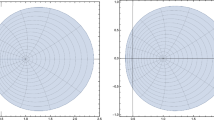Abstract
We consider the problem of solving a rational matrix equation arising in the solution of G-networks. We propose and analyze two numerical methods: a fixed point iteration and the Newton–Raphson method. The fixed point iteration is shown to be globally convergent with linear convergence rate, while the Newton method is shown to have a local convergence, with quadratic convergence rate. Numerical experiments show the effectiveness of the proposed methods.



Similar content being viewed by others
References
Alfa, S.A., Xue, J., Ye, Q.: Entrywise perturbation theory for diagonally dominant M-matrices with applications. Numer. Math. 90(3), 401–414 (2002)
Atalay, V., Gelenbe, E., Yalabik, N.: Image texture generation with the random neural network model. In: Kohonen, T. (ed) International Conference on Artificial Neural Networks (icann-91), Helsinki (1991)
Berman, A., Plemmons, R.J.: Nonnegative matrices in the mathematical sciences. In: Classics in applied mathematics, vol. 9. Society for Industrial and Applied Mathematics (SIAM), Philadelphia, PA (1994) (revised reprint of the 1979 original)
Bini, D.A., Latouche, G., Meini, B.: Numerical Methods for Structured Markov Chains. Oxford University Press, New York (2005)
Casas, P., Vaton, S.: On the use of random neural networks for traffic matrix estimation in large-scale IP networks. In: Proceedings of the 6th International Wireless Communications and Mobile Computing Conference, pp. 326–330. ACM (2010)
Fourneau, J.M.: Computing the steady-state distribution of networks with positive and negative customers. In: 13th IMACS World Congress on Computation and Applied Mathematics, Dublin (1991)
Gelenbe, E.: Random neural networks with negative and positive signals and product form solution. Neural Comput. 1(4), 502–510 (1989)
Gelenbe, E.: Stability of the random neural network model. Neural Comput. 2(2), 239–247 (1990)
Gelenbe, E.: Learning in the recurrent random neural network. Neural Comput. 5(1), 154–164 (1993)
Gelenbe, E., Batty, F.: Minimum cost graph covering with the random neural network. Comput. Sci. Oper. Res. 1, 139–147 (1992)
Hautphenne, S., Latouche, G., Remiche, M.A.: Newtons iteration for the extinction probability of a Markovian binary tree. Linear Algebra Appl. 428(11), 2791–2804 (2008)
Istrc, V., et al.: Fixed Point Theory: An Introduction, vol. 1. Springer, Berlin (1981)
Latouche, G.: Newton’s iteration for non-linear equations in Markov chains. IMA J. Numer. Anal. 14(4), 583–598 (1994)
Mohamed, S., Rubino, G., Varela, M.: Performance evaluation of real-time speech through a packet network: a random neural networks-based approach. Perform. Eval. 57(2), 141–161 (2004)
Ortega, J.M., Rheinboldt, W.C.: Iterative solution of nonlinear equations in several variables. In: Classics in applied mathematics, vol. 30. Society for Industrial and Applied Mathematics (SIAM), Philadelphia, PA (2000) (reprint of the 1970 original)
Rubino, G., Tirilly, P., Varela, M.: Evaluating users satisfaction in packet networks using random neural networks. In: Artificial Neural Networks—ICANN 2006, pp. 303–312. Springer (2006)
Teke, A., Atalay, V.: Texture classification and retrieval using the random neural network model. Comput. Manag. Sci. 3(3), 193–205 (2006)
Timotheou, S.: The random neural network: a survey. Comput. J. 53(3), 251–267 (2010)
Varga, R.S.: Matrix iterative analysis. In: Computational Mathematics, vol. 27. Springer, Berlin (2000)
Acknowledgements
The authors wish to thank Dario Bini for the discussions on convergence properties and Stefano Giordano for providing introduction to the subject of random neural networks and for the interesting conversations on topics related to the paper. The authors wish also to thank the anonymous referees who helped to improve the presentation and pointed out some inaccuracies in the original version.
Funding was provided by Università di Pisa (PRA 2015) and GNCS of INdAM.
Author information
Authors and Affiliations
Corresponding author
Additional information
This work was partially supported by the project PRA 2015 “Mathematical models and computational methods for complex networks” of the University of Pisa, coordinated by Antonio Frangioni. B. Meini is also partially supported by GNCS of INdAM.
Rights and permissions
About this article
Cite this article
Meini, B., Nesti, T. On the solution of a rational matrix equation arising in G-networks. Calcolo 54, 919–941 (2017). https://doi.org/10.1007/s10092-017-0214-7
Received:
Accepted:
Published:
Issue Date:
DOI: https://doi.org/10.1007/s10092-017-0214-7




